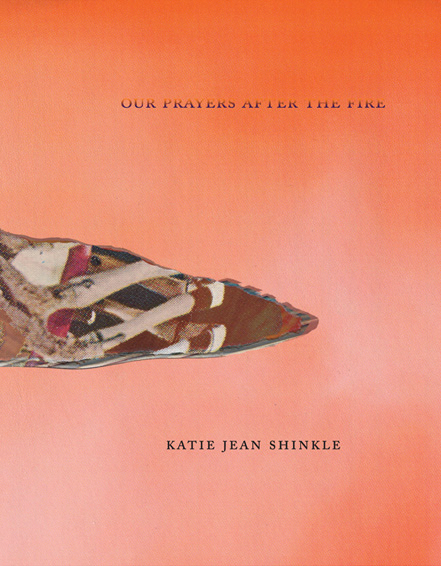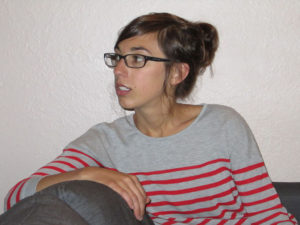
OUR PRAYERS AFTER THE FIRE
KATIE JEAN SHINKLE
ISBN: 978-0-9847063-7-2
Paperback, 205 pages
Blue Square Press, 2014
$12
“We Thrash and Thrash But Nothing”: On Katie Jean Shinkle’s Our Prayers After the Fire
In Katie Jean Shinkle’s first full-length novel Our Prayers After the Fire, readers are led on an eight-month tour of a family cleaving together in the face of tragedy, poverty, and personal turmoil as they seek to craft a version of that abstraction we call home.
In this book, the question of home is understood not just as the house in which a family resides, but as a community that orbits a traumatic event and the body as a space in which the self is at once contained and exhibited. Shinkle explores all of these iterations of home, ultimately fashioning a world teetering on the surreal, where characters visit sailboat graveyards and people forget how to answer the phone. Ultimately, Our Prayers After the Fire offers a kaleidoscope of characters who choose to sacrifice for family, community, and self in haunting and hideous ways.
The book is a tour not only because we travel temporally through two thirds of a year, but because the act of traveling is voyeuristic. When readers experience the intimate and private events relayed, they are consistently reminded that they have not been invited into this world. Rather, they are only bearing witness. As such, access to the book’s internal landscape is delivered with aggressive assertion, as if in defense:
In the early evening, when Father finally gets home and stays home for awhile, we walk to the beach as a family, to the water as a family. We link arms and we hold breaths together, here we walk as a family, this is a family, look at us.
The fragmented storylines of a teenage pregnancy, a vanished father, and a sibling who is constantly under surveillance via the removal of every door in the house provide the fabric of the novel. But it is the urgency and insistence of the narrative voice—depicted through first-person plural—that provides the thread that sutures these and other minor narratives together. Sentences wind labyrinthine, echoing a desire to subsist that is so commanding it leaves the reader metaphorically out of breath. In effect, the run-ons work both to exercise insistence and to exhaust the capacity of the sentence—a practice that echoes the function of hand-me-down clothes.
The fire referenced in the title serves as the launching point for this story, permitting us access to a cast of characters already at risk. Originating in a circus—the perfect platform for introducing the monstrous magic to follow—the fire quickly spreads through the town, killing the circus animals, damaging a train, closing schools, and instigating arrests. In the midst of this trauma, girls rumored to have been murdered by their fathers or abducted by their teachers go missing. Babies are neglected, while “misunderstood men” take their own lives. As eight months unfold and chaos mounts, one can hear the book’s impending conclusion like far-off music from a merry-go-round on which no one is riding.
The use of the circus resonates throughout the novel, even when its overt presence is abandoned. Everywhere characters are queasily laughing, even though “nothing is funny.” This casts a melancholy eeriness over events, making the act of laughing suspect. Girls laugh in an effort to fit into groups of other giggling girls. At other times, such mirth is an anxious response to events that have no appropriate reaction. The question is one of decorum: not what the body does, but what it should do. This idea is made most potent through the threads that deal with young people coming of age. When there is no blueprint for responding to experience, bodies reply without consulting brains—and this is at once a coping mechanism, a violation, and an exercise in ghosting.
In fact, the book makes the argument that the adolescent body itself is haunted: a strange liminal figure that never seems to match the psyche—either because it is left behind, the unfit shadow of a too-mature child, or propelled too far into the future, the under-developed forecast of a future adult. That the book begins in August and ends in March—two months that live in the cleft between seasons and mark transitions in the year—is not insignificant here. At its heart, Our Prayers explores a series of transitory spaces, like the spaces between childhood and adulthood, woman and man, and the plural self vs. a town’s single consciousness. Shinkle navigates this territory with dexterity, interrogating rather than making claims about the relationship between identity and its margin.
The use of first person plural performs another kind of ghosting, as the identity of the “we” is left conspicuously ambiguous. Sometimes this feels like a split self:
We can no longer be a we, we say to her. There is no we anymore. We are going to go far away from the both of them, we say.
Other times it feels like a collective consciousness, as in the scenes where “we” teaches the reader how best to “get sexy.” Is “we” a town, a girl or a boy, or an era? What is significant is that “we” oscillates, and, in doing so, enacts a manifold self, ultimately suggesting that the reader might be part of the equation, as well. Since the book is about the assemblage that characterizes home, it makes sense that its narrative device would rely on the uncanny. The mirrors and specters that populate this novel remind us that finding the familiar foreign and the foreign familiar is most unnerving when it is enacted through the vehicle of the story’s teller.
In one of the first scenes that illustrates the volatility that will fully blossom by the end of the book, Mother uses duct tape to secure bricks around the legs of “we,” then takes “we” to the water:
The waves, our Mother says, are our new home. We scramble against the current, we grab ahold of the edges of rocks that are infested with zebra mussels that cut our hands. Swim, Mother says. When we thrash our legs, our knees hit the bricks just right. The duct tape is unfettered, waterproof. We thrash and thrash but nothing.
That water is an emblem representing the opposite of how home should be characterized (safe, secure, reliable, and founded on routine, comfort, and stability) is a potent example of the managed chaos exercised throughout this book. Our Prayers After the Fire is as monstrous as it is magical, as heartbreaking as it is haunting. We thrash to grow up and on and out, to make the body match the mind; to make the family match the house. We thrash and thrash, though anchored—and still, alas, we make but minor ripples in the tumult of the sea.
 Lindsey Drager is the author of the novel The Sorrow Proper, forthcoming from Dzanc Books in 2015. She has fiction and lyric essays forthcoming in Black Warrior Review, Passages North, The Chattahoochee Review, Hayden’s Ferry Review, and Quarter After Eight. She is a PhD candidate at the University of Denver.
Lindsey Drager is the author of the novel The Sorrow Proper, forthcoming from Dzanc Books in 2015. She has fiction and lyric essays forthcoming in Black Warrior Review, Passages North, The Chattahoochee Review, Hayden’s Ferry Review, and Quarter After Eight. She is a PhD candidate at the University of Denver.